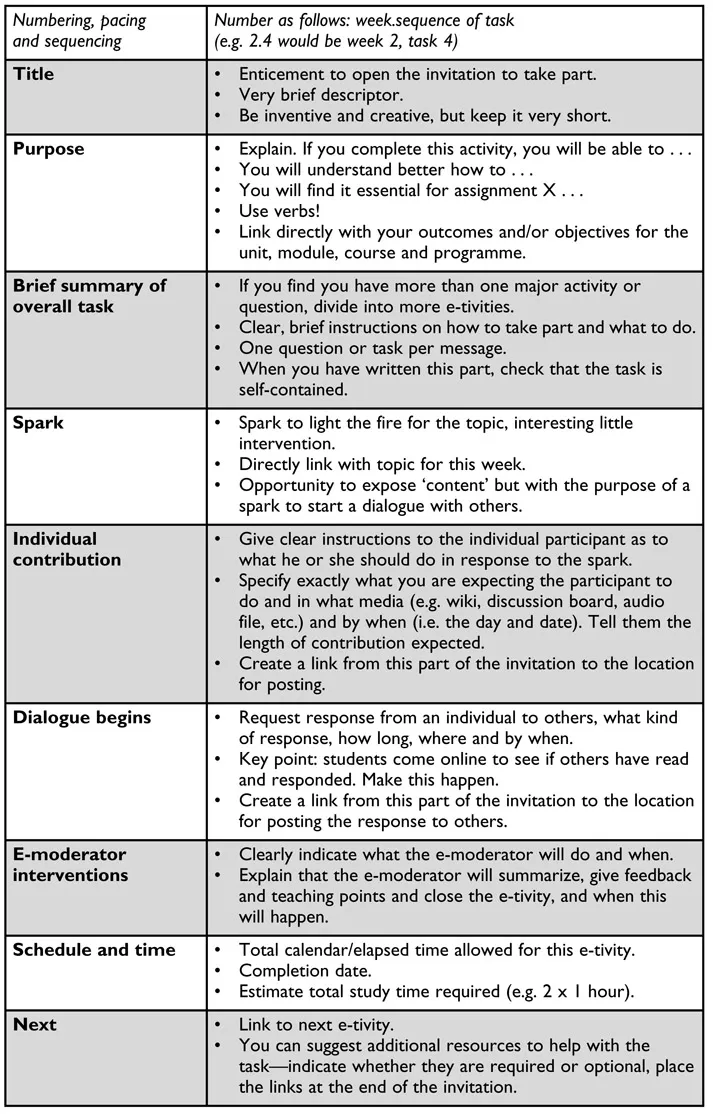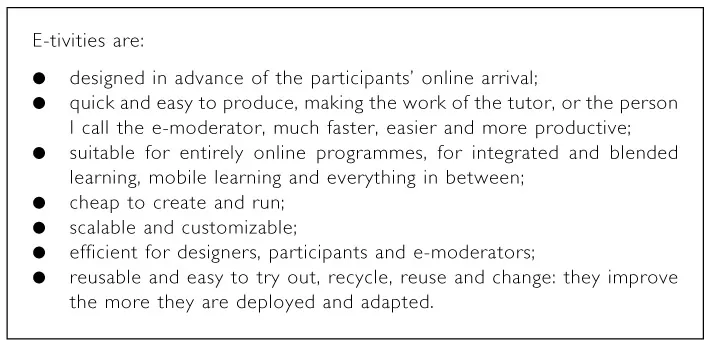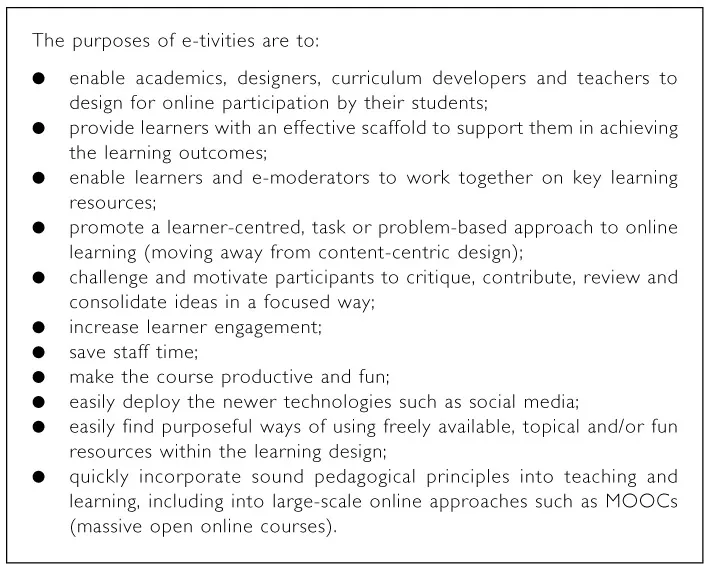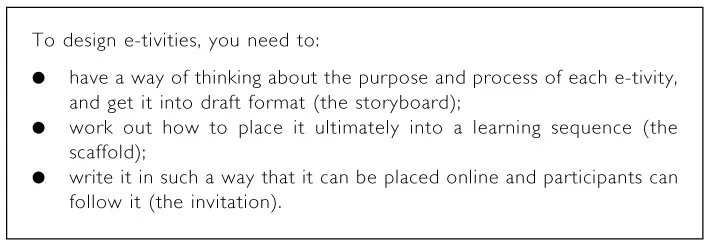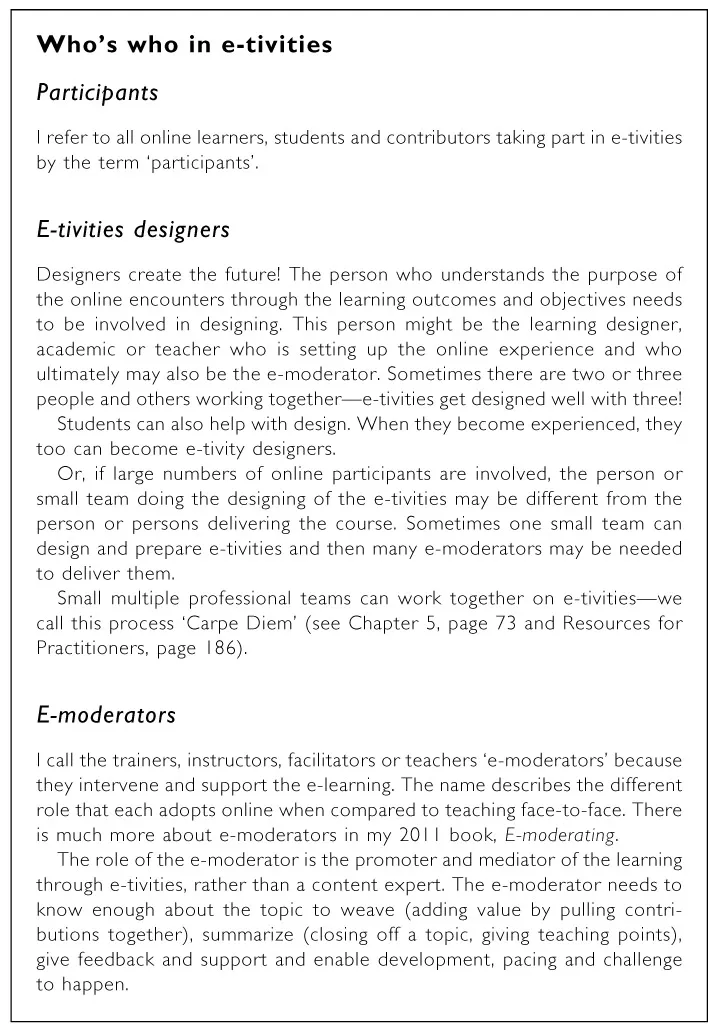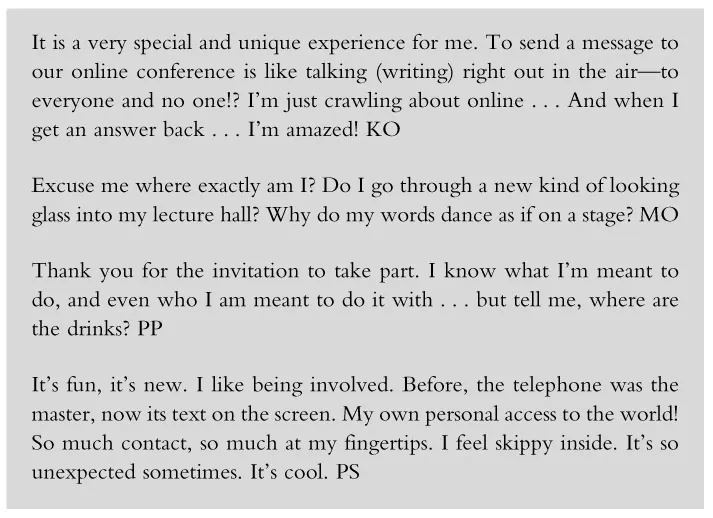![]()
Part 1:
Introducing E-tivities
Table 1.1 E-tivity framework: the invitation
Table 1.2 E-tivity framework: how to create an invitation
![]()
Chapter 1
E-tivities for active online learning
You can bask in the glory of happy, engaged and achieving online students. This book explains and explores e-tivities, the name I give to frameworks for enabling active and participative online learning by individuals and groups. E-tivities are important for the online teaching and learning world because they deploy useful, well-rehearsed principles and pedagogies for learning as well as your choice of networked technologies.
E-tivities do not remove the help and input of more knowledgeable humans—the people I called the ‘e-moderators’—but make their work more focused and productive. They focus on the learners—the people I call the participants, who are contributing, providing, reworking, interpreting, combining most of the knowledge. They overturn the idea that learning depends on one big expert and his/her conveying of knowledge.
E-tivities enable enjoyable and productive online learning for the greatest number of participants at the lowest cost. E-tivities are highly scalable. They are based on the strong idea that knowledge is constructed by learners through and with others. Such processes can happen through online environments just as well as in physical or formal learning and teaching environments, probably better. They work well combined with real-life and real-world environments.
You will find here the original e-tivities research and the learning that has emerged from extensive and intensive 12 years of practice, so you can design and deliver e-tivities for yourself—easily, quickly and effectively.
E-tivities were first developed using text-based computer-mediated environments such as bulletin boards or forums. That’s the easiest place to start. I go on to describe how to use them for many other platforms. Once you get the idea, you will be able to use them in many different ways.
Learning resources and materials (what people once called ‘content’) are involved in the design and delivery of e-tivities, but these are to provide a stimulus or a start (the ‘spark’) to the interaction and participation rather than as the focus of the activity. So e-tivities give us the final break point from the time-consuming ‘writing’ of online courses.
Introducing e-tivities
The boxes below give you a quick introduction to e-tivities: who they’re for, what they can be, where they are valuable, what their purposes are and what you need to produce them.
Stories from the front line 1
Swinburne Online (swinburneonline.com.au) in Australia provides university programmes based on e-tivities and the five-stage model (see Chapter 2), creating an immersive online experience for participants. Chapter 5 describes more ways of designing e-tivities through collaborative teams, which form the basis of Swinburne Online’s design work.
Professor Kay Lipson, Academic Dean for Swinburne Online, tells us more:
In order to ensure that students are exposed to a consistent, pedagogically sound online learning experience, Swinburne Online has successfully developed an explicit set of principles that guide both learning design and delivery.
The learning design process is a collaboration between academics who are the university’s discipline specialists and a learning design team with expertise in online pedagogy, educational technology, online resource acquisition and copyright. Together they design and develop an online learning experience for students that is scaffolded by e-tivities. Each e-tivity is carefully created to ensure that students are engaging meaningfully with their learning materials, their learning advisors and each other.
Learning delivery is conceptualized as a learning journey undertaken by the students and their learning advisors, taking a path navigated by e-tivities. The learning advisors take the role of e-moderators. They facilitate, question and encourage their participant groups. They aim to develop in each student and group an understanding of the relevant knowledge domain as well as a capacity for reflection and self-evaluation. Many of the learning advisors are not traditional academics, but experienced practitioners in their field, trained for their e-moderating roles.
Technology for e-tivities
E-mail, chat groups, bulletin boards and computer-mediated conferencing were developed to enable interaction between people. If a voice or text message is sent, the writer expects a response from some other person. This key characteristic can be harnessed for the purpose of interaction and engagement.
Some of the tools and platforms that we deploy are multipurpose, such as learning management systems (LMSs) and virtual learning environments (VLEs). Throughout this book I refer to them interchangeably as LMS/VLE. Many others were developed for social purposes or for entertainment, communication or business. More about those in Chapter 4, page 57.
I hope to show you that the technologies for e-tivities can promote engagement and activity if they are appropriately used. Promoting robust and usable knowledge through engaging learners in authentic tasks and situations is critically important (Herrington, Reeves and Oliver, 2010).
Combining new ideas about mediation for learning and teaching through technologies and well-established learning theories results in fantastic possibilities, but they need a little human time and energy to get them to work. High-quality interaction, full participation and reflection do not happen simply by providing the technology; hence the need to design e-tivities carefully, to reduce barriers and to enhance the technology’s potential.
Many teachers and trainers at all levels of education are influenced strongly by how they themselves were taught. Most have not grown up learning to take an active part in remote or scattered groups, nor those spanning many different time zones. Many educators miss opportunities for working comfortably and effectively online because they assume that online co-operation and collaboration need to follow similar patterns to classroom interaction (Ehrmann, 2012). The patterns and processes of e-tivities are different, although they draw on the best traditions of active group learning.
Some students are concerned about learning online, even those who are familiar with social media. They see reduced social contact in learning contexts as a real threat. They are anxious about the lack of stimulus and fun from their ‘buddies’ and the potential loss of a special relationship with their teachers, trainers and professors. Somehow, without them, they believe a little magic seems lost! Hence learners need support to develop the skills of working together through interactive technologies of all kinds as well as online contact with leaders and teachers. E-tivities are an answer because they focus on contributing and achieving together.
Creating the future through learning design
E-tivities are best designed and produced in advance of the participants arriving online. Good design processes result in more explicit and higher-quality activity by the participants and enable the development of more effective learning environments and interventions (Conole, 2012). By becoming an e-tivity designer, you are building in a quality learning experience.
E-tivities acknowledge teaching ‘as a design science’ based on continuous collaborative improvement and adaption in practice (Laurillard, 2012, pp. 8–9) and are a way of accessing and digitally applying teachers’ creativity, vision and inspiration (Scharmer, 2009). E-tivities are very firmly rooted in learner-centred and technology-enhanced design in an increasing complex, rapidly changing digital world (Sharpe, Beetham and De Freitas, 2010). E-tivities are a way of actually taking part in the ‘game changing’ that is gathering pace across all types of educational provision (Oblinger, 2012; Bonk, 2009; Ellis and Goodyear, 2010). They offer a viable, principled and practical approach. They acknowledge human systems for learning by developing and evolving; they tend towards order and organization, but via messy experimentation rather than forced imposition. Order arises out of shared values and common interests (Wenger, White and Smith, 2009).
Preparing effective online learning material is a very expensive business in terms of both actual and opportunity costs. It’s brought many organizations to their knees! Few academics or teachers have all the necessary skills, the time or the desire to spend months creating texts and video. Usually there will need to be an ongoing project with one or more subject experts, instructional designers and Web developers. If innovation is required, then add mobile app developers, information specialists, video developers and more.
Some people are very interested in comparisons between working online and traditional face-to-face learning. Others want to talk about the differences between online and print-based distance learning. In practice the benefits and costs are very different compared to campus-based learning. One thing we do know is that the cost of traditional ways of producing materials for online courses is very high, but savings can be made on ‘delivery’ (Rumble, 2010). E-tivities help with saving costs because they use existing resources, are reusable and adaptable and are based on the participants’ exchange of knowledge.
Quality assurance and evaluation processes are essential too, but they add time and require extra effort. Surprisingly, many teaching and learning organizations still start by developing resources of this kind, as they seem to be the safest ‘way in’ to e-learning. Then they find that there are no quick fixes, only expensive experiments and ‘pilots’ that fail to lead to ‘scale-up’.
Rather than pursuing such developments, organizations should know that e-tivities are lower risk, lower cost and a better place to begin—they inform prototyping and decision making too. If e-tivity development is built into a structured local team process, then capability is built up across the organization (see Chapter 5).
The participants’ experience of learning through e-tivities
Working with others online can be playful, liberating and releasing. Online participants are often more willing to try things out in a dynamic way than they would be face-to-face, which means that e-tivities can be more fun and still promote learning. Emotions can often surface and be expressed when they could not do so in face-to-face situations. We know that involving emotions helps to promote reflectiveness (Moon, 2006).
In the search for engagement of learners, e-tivities have proven to have a special place. New online participants wrote to me about their experiences:
Participants who are working in a language other than their own have a particularly sharp learning curve. This participant reported her experience:
Teachers as e-tivity designers
Many traditional teachers are surprised at how much learning can go on through structured online networking. You might be interested in this e-mail I had from a colleague, a very experienced distance learning teacher in the UK Open University Business School.
Stories from the front line 2
Transforming the group experience
Don led a team that produced a residential weekend school; then, with a colleague, he turned to the task of preparing an online equivalent of the residential school. He e-mailed me about his experiences.
We thought our job was to write the programme for the residential school. If we thought about the online version at all, we saw it as something that would be an imitation of the residential. We never said ‘pale imitation’, but I sense that the categorization was there in our minds.
How wrong we were. How much the preparation—the design, the reworking of the residential material—and the observation of the online school in action have changed my mind. The online school revealed itself as a remarkable event. As we worked on the design, and as we subsequently observed the virtual exchanges, so the remarkable features of the online environment came into view, one by one.
At residential schools, the contributions by the students are oral, short and immediate. During the sales and marketing role-play exercise, students air their initial thoughts on the task, and the only sources of ideas, concepts and models from the course are the students’ own memories. One member typically captures these ideas, in abbreviated form, on a flip chart. By contrast, online, everyone has a full record of everything that has been ‘said’. The contributions are considered in a way that is not possible at face-to-face schools. There is scope for thoughtfulness and for reflection.
The role of the face-to-face tutor also differs from the role of e-moderator. At the residential school, the tutor may join a group for a while, sense what’s going on and contribute as judgement directs, then leave. The tutor also acts as a ‘postperson’—to deliver the handouts! Because the e-moderator hears (reads) everything that is said (written) and can contribute, in an equally permanent fashion, without disturbing the discussion, the online experience challenges this familiar model. A student posts a thoughtful message, which is read not only by the group but by the e-moderator too. Another follows this. The e-moderator acts more as a commentator than a facilitator in such a circumstance. Online, not only does the e-moderator post the handout but he or she can also comment on it—act as a mediator between the content and the learning.
Don Cooper, Open Un...


